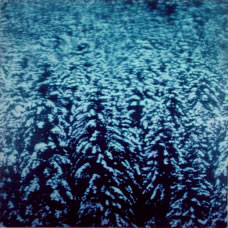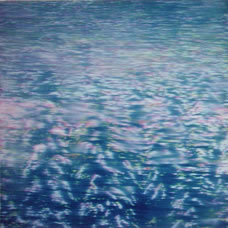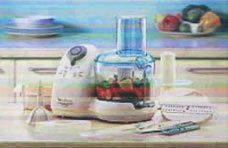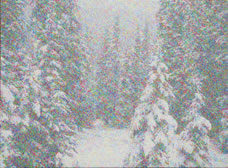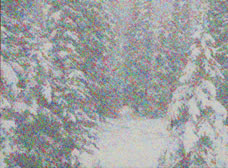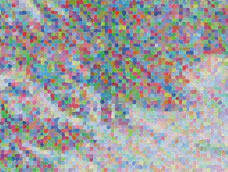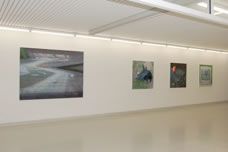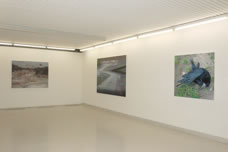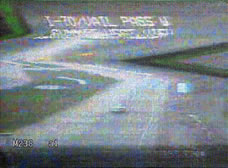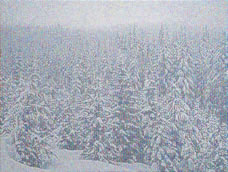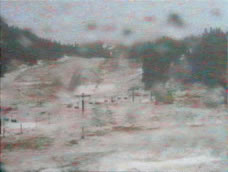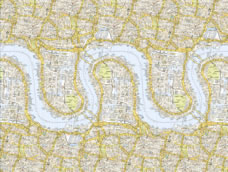ANNUAL PROGRESS REPORT
Dan Hays, June 2010
Research title:
Painting in the Light of Digital Technology
PAINT DRIES AS SNOW MELTS
One morning in January 1996, staying in the mountainous Auvergne region of France I awoke to find that it had snowed on the pine forest overnight. I took numerous slide photographs of the astonishingly beautiful scene, and after processing back in London, was intrigued by how these images looked in miniature. They reminded me of white noise or “snow” on a TV screen. In their painting, using a dragging technique, I was excited by the effect of a frozen video frame rather than a still photograph that emerged by accident - a more transient and fleeting kind of picture, in contrast to the monumental nature of the subject matter.
What follows are some notes and quotes partly made up of previous texts produced for my website since commencing research here at Kingston. These correspond to an intermittent engagement with depicting snow scenes since a series of paintings titled Spring Snow in 1996. This is one of possibly three interwoven strands of research with the misleadingly simple titles:
WATER AND MIRROR
ICE AND GLASS
SNOW AND SCREEN
I’m going to take some time to get there. I’ve found that in order to explain anything I need to go back to some kind of foundational substrate of ideas and materials – the raw canvas and paint if you like, or the matrix of the screen. My development as a painter, and more recently as a printmaker, is not led by philosophy and art theory but retrospectively informed by it, or perhaps more correctly, complicated by it, as I have found. This is a slow process of discovery, and my thinking towards the written part of the research is to engage in the work of a selection of other artists in the same manner that my work has progressed over the years. Just as I’m guided by an attraction to very particular photographic source material, perceptual conundrums and technical challenges that flurry, coalesce and settle uncertainly through accident and intuition, an accumulation of artists has built up whose work has helped to inform my thinking. I will introduce one of these cases at some length later on.
A quote from Norman Bryson’s Vision and Painting – The Logic of the Gaze, sums up my fascination with the medium of painting:
[...] Composition under realism is this shifting of forms between two and three dimensions, subject always to the Gaze, the fused epiphanies, in which both sets of dimension equally participate: in the Gaze, the image is both the depth of the founding perception, and the flatness of the picture plane.
This seems especially true of painting, as opposed to other visual media like photography, film and video. Greenberg’s view of Modernism closed off painting’s engagement with illusionism in favour of the absolute realism of the picture plane and painted substance. I never got this. For me, what is special (though not exclusive) to painting is precisely the coexistence of surface and illusory depth, an unfinished business explored by Impressionism and Symbolism – most profoundly by Monet and Cezanne.
Photorealism (the genre of painting that my work is superficially most closely associated with) has largely aimed to reconcile the purely illusory intentions of photography with variously expressive or sophisticated painting techniques. Attention to the optical limitations of lens-based media, like black and white reproduction or the snap-shot aesthetic, tend to focus on the condition of the photograph as an object - a momento mori – or an indexical touchstone to reality (whatever that is), or a media-distorted view of it, which is our generally accepted viewpoint now.
I’m interested in a different level of realism, one that is closer to exploring the vagaries and limitations of human perception - and by extension, human experience, for me revealed or questioned most potently by the advent of video, digital photography and computer simulation. I say advent, for the workings of these media are receding from view with ever-higher screen resolutions and rendering speeds.
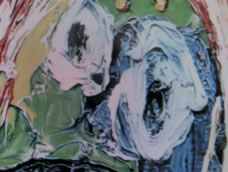


Details of a screen image: Love Never Dies, 1993, oil on canvas by Glenn Brown
The optical functioning of painting and the TV screen, whether cathode ray or LCD, seem diametrically opposed. Paint is effectively coloured mud. Perception of colour is produced through the reflection of incident light. Screens produce projected light, the colour produced by three component primaries: red, green and blue. As anyone who works in the digital photographic industry knows, the calibration of screen and printed image is an almost impossible task – the printed (or painted) image is experientially different from that of the screen. My contention is that there is an experiential meeting point at lower resolutions, one that is founded in an engagement with the tactile or haptic nature of perceiving the mechanics of illusionism at the level of physical daubs of paint or visible pixellation.
This is accentuated by processes of image compression, which has been my main visual or sensual concern within my work for the last decade. Faithfully reproducing and accentuating digital mistakes and glitches is a painstaking process, working from computer printouts and projections. By alternating the pigments used in colour mixes and deliberately or accidentally pushing colour and tone away from the original, the immaterial and instantaneous digital information is given material and temporal existence in fleshy brushstrokes and daubs.
Laura Marks, in Touch: Sensuous Theory and Multisensory Media, argues the case for an engagement with haptic visuality:
That vision should have ceased to be understood as a form of contact and instead become disembodied and adequated with knowledge itself is a function of European post-Enlightenment rationality. But an ancient and intercultural undercurrent of haptic visuality continues to inform an understanding of vision as embodied and material. It is timely to explore how a haptic approach might rematerialize our objects of perception, especially now that optical visuality is being refitted as a virtual epistemology for the digital age.
[...]
In haptic visuality the eyes function like organs of touch. [...] The difference between haptic and optical visuality is a matter of degree, however. In most processes of seeing both are involved, in a dialectical movement from far to near, from solely optical to multisensory. And obviously we need both kinds of visuality: it is hard to look closely at a lover’s skin with optical vision; it is hard to drive a car with haptic vision.
The push-pull between haptic and optic vision seems most clearly articulated by a certain kind of representational painting – Impressionism, and recent forms of technological vision. Digital image compression has striking formal associations with the Impressionist imperative to capture the essence of a scene as quickly as possible with a restricted palette of colours, regarding the scene as a whole, employing brushstrokes of a similar size, and returning to the same view in different light conditions. This is a special relationship, where we can see digital photographs as proto-paintings, abstracting visual information, creating painterly effects several removes from the world.
A quote from the poet Jules Laforgue in 1883, talking about Impressionismserves to explain my wonder at this proximity of impressionist technique and the automated processes of digital technology:
[...] a natural eye forgets tactile illusions and their convenient dead language of line, and acts only in its faculty of prismatic sensibility. It reaches a point where it can see reality in the living atmosphere of forms, decomposed, refracted, reflected by beings and things, in incessant variation. Such is this first characteristic of the Impressionist eye.”
Foregrounding the optical apparatus or illusion generating technique presents in various ways a prismatic sensibility as opposed to the notionally transparent, monocular viewpoint presented by linear perspective and the lens. Human subjectivity can be questioned or enlightened through attention to the technological gaze, or the poet Jules Laforgue’s “natural eye”. “Prismatic sensibility” seems to offer a way forward in thinking about some kind of merging of the oppositions of haptic and optic, surface and illusion, and the human and technological.
To quote Heidegger:
Thus questioning, we bear witness to the crisis that in our sheer preoccupation with technology we do not yet experience the coming to presence of technology, that in our sheer aesthetic-mindedness we no longer guard and preserve the coming to presence of art. Yet the more questioningly we ponder the essence of technology, the more mysterious the essence of art becomes.
Artists have engaged with advances in theories of perception and optical technology since the Renaissance, via Brunalesci, Newton, Goethe etc, etc. In the late 19th and 20th century mass-reproduced photography, film and television produced material for artists to react against, question and manipulate, through Impressionism, Cubism, Dada, Surrealism, etc. to structural filmmaking in the 1960s and 70s. Digital technology has simply accelerated the proliferation of ways to manipulate forms of optical visuality inherent with the lens and the virtual screen to haptic, sensual effect.
Is it reassuring to engage with visual material and processes that reveal the flaws and limitations of technological representation, in a sense humanising it, giving it material, corporeal form? Is some kind of gothic or uncanny sensibility inevitable, born of a fear of all-powerful, incomprehensible technology – a common theme for horror dating back to the 19th Century? Or is the nostalgia for outmoded, tangible forms of visual mediation like painting, film or analogue video justified in response to the near-hegemony of the high definition screen? Can the synthesising nature of digital technology, the merging of the real with the virtual, in fact bring us closer to a supposed accurate, objective depiction – an augmented reality? Or will humankind be consumed by the technological sublime – prismatic sensibility integrated perfectly into code?
All these questions and others have occupied my thoughts around the subject, and tend to spin out of control, so I will get back to the matter of snow and paint, outlined at the start – a way into these themes driven by my own work, some key texts, and the work of contemporary artists.
Snowscapes are black and white, or at least the absence of colour, so long as the sky is grey, is not immediately apparent in many cases. In these works the snowy scene is depicted with pixels of pure saturated colour.
From a long distance these points of colour optically merge and form a greyscale image, revealing the subtle tones required to appreciate the forms of pine trees or line of a hillside. At close range colour perception takes over and the impression is one of abstracted coloured noise.
These paintings play with ideas of the white noise between TV channels; with landscape as background and background radiation; and with paying perverted and futile homage to the use of additive colour implemented by Impressionism and Pointillism.
Whereas the intentions of these movements was to emulate the immediacy of atmospheric scintillation, representing a ‘natural’ impression of a scene bathed in light, the use of pure colour to represent a grey landscape seems a ridiculous optical overindulgence; the metaphorical connections between snow, whiteness, silence and purity are subverted through the pathos of exuberant, noisy colour.
Charles Harrison’s essay, On the Surface of Painting, provides a fabulously useful context for thoughts about snow and my attraction to a particular type of painting. He uses Lucas van Valckenborch’s Winter Landscape, painted some 400 years ago, to introduce complex ideas around the tension between perceptions of surface and illusion of depth. This is whilst acknowledging that the painting is a mediocre example of the popular landscape genre of depicting the four seasons:
Across the surface of the canvas and scarcely diminishing in scale from bottom to top, touches of white paint represent falling snow. It is not a small painting and these are not mere feathery indications, but palpable dabs from a loaded brush. To a taste fed on Modernist painting […] it is by virtue of this surprising frankness that the painting achieves more than anecdotal charm. It is not the illusion of depth in the picture that holds our sophisticated attention, nor the atmospheric re-creation of a leaden sky, nor do we admit to being engaged by the over-rehearsed animation of the peasants. What gives us pleasurable pause is that strange and distinctive form of scepticism about appearances which is set in play when the allure of imaginative depth meets resistance from the vividness of decorated surface.
What is meant by scepticism here is not some hostile withdrawal of sympathy on the part of the viewer. It is rather an imaginative reconstruction of the artist’s enterprise: an alertness to artifice; an appreciation in this case that the picture must have been painted to be snowed on.
He goes on to say:
We appear to be assuming that the manifest facticity of those touches which signify falling snow is a function in some intentional system of artifice and reflexiveness, and not the mere accidental result of incompetence on the part of a painter who would have produced a more seamless illusion had he been technically able – had he possessed the kind of skill, for instance, displayed by Monet in his painting of Snow at Argenteuil.
But is this assumption actually implied? Are the relations between intention and competence quite so easily decided? And what if we said that, while Monet was painting a decorous and suburban fall of snow, an effect for which the technology of Impressionism was well suited, van Valckenborch was painting a blizzard, a natural event which strains the competences of painting itself?
Harrison outlines a form of painting which questions notions of competence and stylistic flare. When I read this felt like a moment of epiphany:
The act of perception is an act of consumption in which we hazard nothing. The world of our own antecedent associations is pandered to and privileged in ways which distract us from the uninteresting contingencies of the work’s production, and thus from the relative ordinariness of what it is actually of.
By contrast, the kind of painting I have in mind is one which presents some aspect of its own production as a bar to unreflective consumption; which renders problematic the relationship between what it represents and how it represents it; which figuratively embodies time as a necessary aspect of its own coming-into-existence[.]
To my mind, Robert Ryman would fit the theme of Charles Harrison’s essay perfectly, if allowed to make symbolic connections between white paint and snow.
but also the work of two young Danish painters I showed with last November in Copenhagen, Marie Sondergaard Lolk and Allan Otte in an exhibition titled Parallel Lines.
Installation shots of Parallel Lines at Tom Christoffersen Gallery, Copenhagen.
I presented three paintings:
"Vail" is an obsolete spelling of “veil”, as in shroud, but also suggests “vale”, meaning a valley, as in vale of tears. The associations of veil and screen combined with the allusion to landscape was irresistable. It’s a heavily layered work, distressing the nebulous and corrupted image further to thresholds of recognition as a scene, through colour modulation and more expressive mark making than much recent work. The possibility of passing through is exactly what this painting tries to frustrate.
Colorado Snow Effect 7 attempts to extend the optical effects in Colorado Snow Effect 5, colour was pushed towards red, green and blue in verticle bars across the image. This references, in low resolution, the red/green/blue primaries comprising video screens, and forms an intermediate optical "holding pattern". From a distance the painting appears greyscale, then on approach the coloured bars become more noticeable, before largely dissolving close-up, as more saturated colour takes over.
With Colorado Snow Effect 8 I was drawn to an image from a ski-resort webcam near the end of the winter season, suggested by the predominance of red, earthy tones showing through the slush. Ice can be seen melting on the surface of the camera housing, echoed by the rendering of the painting in glazed greyscale daubs of paint on the painting’s surface at close range.
Allan Otte invited me to write a catalogue essay for his exhibition Efterbilleder (After-images) taking place at glHoltegaard and KUNSTEN - Museum of Modern Art Aalborg. Following is the last section:
Essential to Otte’s process of working is masking tape. It was invented in 1925 to aid painters in the car industry, forming a neat material link to his subject matter. The hours spent cutting away and revealing areas to be painted can scarcely be imagined, yet necessarily impose a restriction on the amount of detail that can reasonably be achieved. Instead of applying uniformly flat colour within these masked-off sections, the paint is either airbrush sprayed, or successively dragged across in what I will call “streaked-brush” applications — for this vibrant method of painting seems unique to Otte’s work.
Airbrushing suggests car spray-paint, or the fuzzy immateriality of out of focus photography and blurred CGI. It’s often used in Otte’s work for passages of sky, and sometimes for other forms. The painting Indgreb (Interference) shows the metaphoric potential of this technique. Within the vast artificial canyon created by a limestone quarry, mark making on an industrial scale is represented by the hands-off caress of a stream of air. The very ground exploited by technology for raw material is shown exhausted — as intangible vapour.
The striated parallel lines within the “streaked-brush” areas are rigidly oriented either horizontally or vertically, or, more recently, within concentric circles. These sections follow their own internal logic, often working with or against the structure of things. The diagonal slopes of roofs, or walls in perspective are flattened.
Receding fields can be represented with horizontal marks, yet a vertical rendering can describe the texture of grass. From a distance, the flaws and fluctuations of brush-stroked colour and stripes seem to approximate — and to magically stand in for — the missing detail usually caused by the limitations of the masking technique.
These fragments of image present an intermediate level of simulation within the represented view. Largely dependent on colour, they appear to have the surface qualities of wood grain, brushed metal or grooved plastic. We’re presented with a jigsaw of wooden veneers, akin to the craft of marquetry, or an engineered metal and plastic construction, curiously flattened out.
This second-order material illusion, lying in front of the pictorial one, traps the viewer in a perceptual ambivalence, on a screen between a realistic landscape depiction and the physical actuality of paint.
The optical ambiguities between flat or faceted surfaces and ethereal, gaseous mists within Otte’s paintings encompass technology’s history: from a time-consuming artisanal medium, to industrial manufacturing, and the virtual realm of CGI.
There’s also a link to the visual technology of painting. In “synthetic” Cubism sections of found materials, such as newspapers and prints of wood grain, were collaged into still life compositions instead of being represented in paint. The radical break with perspectival space gained added potency with a proximity to trompe l'oeil illusionism. Cubism, and its profound influence on modern aesthetics, can be viewed as a kind of perceptual car crash, shattering integral forms into pieces, echoing societal break down and fractured subjectivity.
These broken, fragmented remains are simulated and reconstructed on the surface of Otte’s paintings, in organic and crystalline formations. Hand-painted trompe l'oeil surfaces are sublimated in service to a greater illusion — that of a fully integrated depiction of a landscape. The focussed intensity of this labour can present a melancholic or desperate vision. Technology that has gone wrong is being made right.
Blomstermaleri (Flowerpainting)presents the poignancy of this situation, and indicates the metaphoric significance of Otte’s use of acrylic paint. If acrylics have a material association it’s with plastic: a product of the petrochemical industry, characterised by its artificiality, malleability, durability, and bright synthetic colours. So these blooms are rendered in eternal and lifeless plastic, their symbolic reference to transience and mortality all but severed. They pay appropriate tribute to a simulated crash scene; the vestiges of human devotion encapsulated in a machine-like, synthetic painting technique. Dissociated contemplation is now made everlasting by acrylic painting’s physical substance.
A quiet apocalypse is meticulously presented across Otte’s recent work. His choices of subject are curiously banal and devastating at the same time. Exhaustion of late-capitalist society’s material and emotional resources are coolly staged as painted hallucinations. Yet with their startling illusionism and hand-made materiality, the paintings wage a heroic battle against this technological and sociological abyss. Confronted by a baroque explosion of painterly colour and texture at the micro level, we can actually imagine these destructive and entropic processes in reverse.
Otte’s obsessive, forensic reconstructions signpost a piecing back together that’s set to continue. The contorted crashed car will re-integrate, re-mould and right itself onto the road, reversing back to the beginning of its very long journey, taking us far away from the vanishing point.
Fear of the vanishing point is not simply a reactionary technical response to seamless high-resolution computer simulations, but an existential or phenomenological imperative. The charming, rarified absurdity of the outmoded technology of paint on canvas offers a mediating screen between the cool, indifferent lens of the digital and the fluid symbiosis of eye and brain – the prismatic visual coalescence of technology and nature. Three material or symbolic links have come to light through this thinking, extremely (and perhaps appropriately) nebulous at this stage, as I mentioned at the start:
WATER AND MIRROR
ICE AND GLASS
SNOW AND SCREEN
And some of my work over the last year has begun to mess with these elemental and optical pairings.
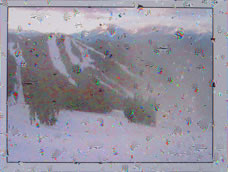
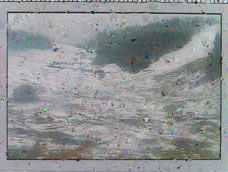

Stemming from my attraction to the image used for Colorado Snow Effect 8, I sourced a myriad of low-resolution Colorado snow scenes and experimented by splashing my computer screen with water. The droplets magnify the underlying red-green-blue substrate of the monitor. The frozen landscape is animated by jaunty globular figures, forming a melted material link to the snow scene, but also, I hope, a further visual conundrum in the resulting painting, Colorado Snow Effect 9.
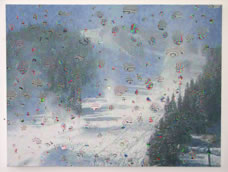
An excerpt from Rosalind Krauss’s Grids essay of 1979 opens up this territory:
As a transparent vehicle, the window is that which admits light – or spirit – into the initial darkness of a room. But if glass transmits, it also reflects. And so the window is experienced by the symbolist as a mirror as well – something that freezes and locks the self into the space of its own reduplicated being. Flowing and freezing; glace in French means glass, mirror, and ice; transparency, opacity, and water. In the associative system of symbolist thought this liquidity points in two directions. First, towards the flow of birth – the amniotic fluid, the “source” – but then, towards the freezing into stasis or death – the unfecund immobility of the mirror.
Today that mirror/window has its equivalent in the TV or computer screen, with elemental associations to the flood of images generated by the Internet (the digital wilderness, to romanticise), and the fluidity of the space between the virtual and actual.
“Flowing and freezing” also hints at a phenomenological and symbolic connection to the substance of paint – ordinarily described as “flowing and drying”. Yet oil paint never truly dries, unlike its watercolour and acrylic cousins. Vestiges of plant oils remain congealed in its resinous body. “Freezing” seems a more appropriate way of describing this slow process of mummification or cryogenics.
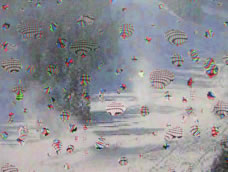
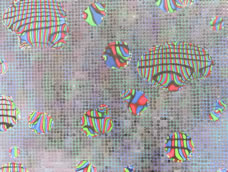
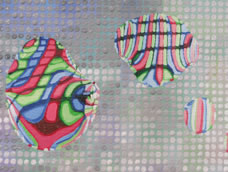
A text presented to the reading group last year by Maria Fusco, Daniel Tiffany’s Lyric Substance: On Riddles, Materialism, and poetic Obscurity, offered a way into thinking about the coalescence of thought and matter in the context of poetry, for me translatable across to ideas concerning the immateriality of the digital being substantiated into paint, and Bryson’s “fused epiphanies” of illusion and surface:
The iconography of lyric substance constellated about the phenomenon of "darkness visible" provides a framework-remarkably stable throughout literary history for depicting correspondences between the poem's nebulous body and certain amorphous bodies in nature. [...] Natural philosophers repeatedly visualized the invisible foundation of matter as a kind of weather. Hence the corporealization of obscurity in lyric poetry frequently coincides, in its particulars, with the depiction of invisible substance in the history of philosophical materialism.
Citing a poem by Jorie Graham, he continues:
The Dream of the Unified Field begins with a meditation on a snowstorm, an amorphous body that appears and reappears in the image of other bodies. [...] The poet returns repeatedly to the memory of the storm as an image of "the constant re-patterning of a thing" and of the mysterious in-side of things:
Filaments of falling marked by the tiny certainties of flakes. Never blurring yet themselves a cloud. Me in it and yet moving easily through it.
The imaginative and philosophical changes "rung" on the snowstorm (which reflect the mutability of the phenomenon itself) coincide with the reciprocation of interior and exterior spaces. The "certainties of flakes" become bits of sleep and thought that accumulate to become the imagined objects of an interior climate:
The storm: I close my eyes and,
standing in it, try to make it mine. An inside
thing. Once I was... once, once.
It settles in my head, the wavering white
sleep, the instances-they stick, accrue,
grip up, connect, they do not melt. I will not let them melt,
they build, cloud and cloud.
The nebulosity of the material storm and the solidity of intellectual objects coincide because the blind, possessive, agglutinative mode of composition is the same in both cases. Ultimately, the storm that is reassembled in the mind reveals itself to be a "possession" of history, a "splinter colony". Indeed, in a startling transformation, the snow-storm becomes the "vast white sleeping geography" of the "new world" discovered by Columbus - the very substance of a unified field of matter, thought, language, and history.
This idea of a unified field of matter and thought, representation and abstraction, actual and virtual, has been close to all my work over the years in one way or another. Claude Monet’s late water lily paintings present the most startling visual case, to my mind, fusing the perceptual complexities of screen and mirror, if we ignore the chocolate-box associations. (Although, this cynical viewpoint sets up another dialectic to diffuse: between the once radically avant-garde and the overwhelmingly kitsch).
The surface of the water abstractly reflects plants and sky around the pond. The subject functions as an allegory of painting. We have the actuality of paint on the canvas surface, between our side of the screen and the illusory beyond. The painted water lilies floating on the pond surface are suspended between the reflected landscape and the imagined shadowy depths.
This is where distinctions between Impressionism and Symbolism fall apart, and can be seen as optically and metaphorically functioning within a continuum, as Richard Shiff explains with a nifty little diagram in Cezanne and the End of Impressionism:

In the diagram, the top group of elements – temperament, emotion, ideal – are “internal” and constitute an image of the self; they relate to mental, psychic, or imaginative activity. The bottom group of elements – nature, impression, effect – are “external” and form an image of the world; they relate to physical or sensory activity. The elements located “before” the means of expression – emotion and impression – are individual, subjective, and private; those located “after” – ideal and effect – are (if the work of art is optimally successful) universal, objective, and public.
Trying to formulate what could possibly be optimally successful in Shiff’s terms, given the impoverished, arbitrarily composed, low-resolution webcam images I have a liking for is hard to envisage. Pushing the tensions between temperament and nature, emotion and impression, and ideal and effect to breaking point is more my thing.
The Terra Foundation is an American organisation based at Giverny in France, next door to Monet’s old house and his elaborate water features. I applied for a well-funded residency this summer, explaining my uncanny connections both to French and American art and culture, with my interests in Impressionism, American Luminism, and the real Dan Hays in Colorado, of course.
After waiting for over two months for a response to my application I received a letter saying I hadn't been successful. Unperturbed (with no taste of sour grapes whatsoever), I’ve embarked on a new painting based on an assemblage of found photographs of a lake in Rocky Mountain National Park, Colorado.


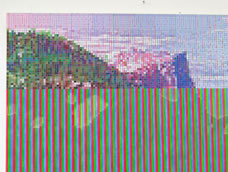
Nymph lake is Giverny’s super-sized American twin – an artificially engineered perfection of nature, which is being rendered in pure, saturated colour above a shimmering substrate of televisual stripes.
It seems this is as close to an attempt at realism as I’m going to be allowed from a vantage point within this seemingly endless urban metropolis.

